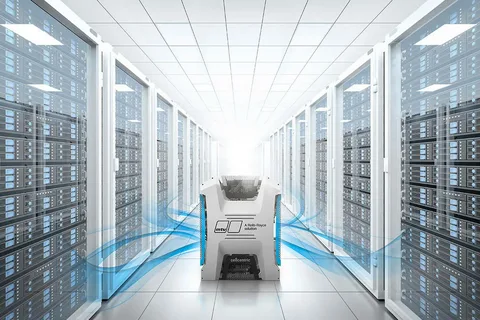Table of Contents
The Hidden Science That Keeps Your Data Safe
Computational fluid dynamics has become the unsung hero in Singapore’s battle to maintain digital infrastructure reliability amidst challenging tropical conditions. In the glass and steel buildings that house the nation’s growing data centre industry, engineers work tirelessly to model the invisible: the flow of air molecules around densely packed servers generating heat that, if left unchecked, could lead to catastrophic failures. Behind every successful online transaction, every cloud-stored document, every streaming video, stands this quiet science—preventing meltdowns you’ll never hear about.
“Singapore’s unique climate presents extraordinary challenges for data centre cooling. With ambient temperatures averaging 27-31°C year-round and humidity often exceeding 80%, computational fluid dynamics modelling isn’t a luxury—it’s essential infrastructure.” — Dr. Tan Wei Ming, Singapore Institute of Technology
The Perfect Storm: When Power Meets Heat
The relationship between power protection and thermal management resembles a high-stakes chess match played against the laws of physics. When standard power supplies falter—as they inevitably do—a chain reaction begins that can rapidly escalate into disaster:
-
Servers switch to backup power, creating transitional heat spikes
-
Cooling systems momentarily hesitate during the power transfer
-
Temperature-sensitive components edge closer to their operational limits
-
Microsecond timing decisions determine whether systems survive or fail
The Invisible Enemy: Hotspots and Dead Zones
What makes cooling data centres particularly challenging isn’t the total heat load—substantial though it is—but rather the uneven distribution of heat. Like a military strategist mapping terrain, engineers use computational modelling to identify the battlefield’s critical points:
-
High-density server racks creating localised heat islands
-
Dead zones where cooling air fails to circulate efficiently
-
Recirculation patterns that allow hot exhaust air to contaminate cool intake zones
-
Bypass flows where precious cool air escapes without performing useful cooling
The Singapore Challenge: Tropical Conditions Meet Digital Demands
For Singapore’s data centre operators, the challenge is particularly acute. The city-state’s strategic position as a digital hub for Southeast Asia means failure is not an option, yet environmental conditions actively conspire against reliability.
“When modelling cooling needs for facilities in Singapore’s climate, we must account for worst-case scenarios that would be inconceivable in more temperate regions. Our CFD models must incorporate humidity factors and outside air temperatures that rarely drop below 25°C, even overnight.” — Singapore Data Centre Consortium
The Power Paradox: When Protection Creates Problems
The uninterruptible power supply for servers—the very system designed to maintain operations during outages—can sometimes exacerbate thermal challenges. When UPS systems engage, they introduce new variables into an already complex equation:
-
Battery systems generate their own heat while discharging
-
Transfer switches momentarily interrupt cooling systems
-
Generator start-up sequences create vulnerable transition periods
-
Power conditioning equipment adds additional heat load to the environment
The Digital Detectives: Finding Flaws Before They Manifest
Modern computational fluid dynamics acts like a time machine, allowing engineers to see potential failures before they happen. Using sophisticated modelling, they simulate thousands of scenarios, identifying vulnerabilities that would be impossible to detect through conventional testing:
-
Virtual smoke tests reveal airflow patterns invisible to the naked eye
-
Thermal imaging simulations pinpoint hotspots before they become critical
-
Pressure mapping uncovers inefficient cooling distribution
-
Time-lapse modelling shows how heat accumulates during extended power events
The Financial Imperative: Where Physics Meets Economics
Beyond the technical challenge lies a compelling business case. In Singapore, where electricity costs rank among the highest in the developed world, efficiency isn’t merely environmentally responsible—it’s financially essential:
-
Every percentage point improvement in cooling efficiency translates to significant operational savings
-
Reduced cooling requirements mean smaller uninterruptible power requirements
-
Extended equipment lifespan from proper thermal management delays capital expenditure
-
Insurance premiums decrease with demonstrated reliability during power events
The Human Factor: Where Expertise Transforms Models Into Reality
Despite the sophistication of modern computational tools, the human element remains irreplaceable. The most accurate model becomes worthless without the expertise to implement its findings correctly:
-
Engineers must translate theoretical models into practical infrastructure decisions
-
Operations staff need intuitive understanding of how power and cooling systems interact
-
Maintenance protocols must prioritise the components most critical to thermal stability
-
Emergency procedures must account for the complex interplay between power and cooling
The Future: Predictive Systems and Machine Learning
The next frontier combines computational fluid dynamics with artificial intelligence to create systems that not only model environments but actually predict failures before they occur:
-
Machine learning algorithms identify subtle precursors to cooling inefficiencies
-
Automated systems adjust cooling distribution in real-time response to changing conditions
-
Predictive maintenance replaces components before they impact thermal stability
-
Power systems anticipate and compensate for fluctuations that could affect cooling
The Essential Balance
In the digital age, where instant access and perfect reliability are not merely expected but demanded, the invisible science of airflow management represents the thin line between success and catastrophic failure. For Singapore, maintaining its position as a digital hub means staying at the forefront of this science.
As data centres grow denser and processing demands increase, the fundamental challenge remains unchanged: maintaining the delicate balance between generating enormous amounts of heat in a confined space while ensuring that heat never compromises the very systems producing it. The future of our digital infrastructure depends on this ongoing mastery of thermodynamics, fluid dynamics, and power management—specifically, the continued refinement of uninterruptible power supply UPS.

